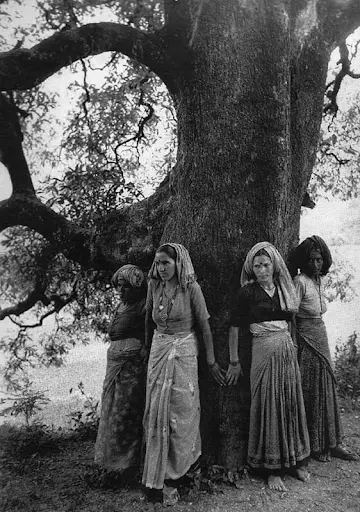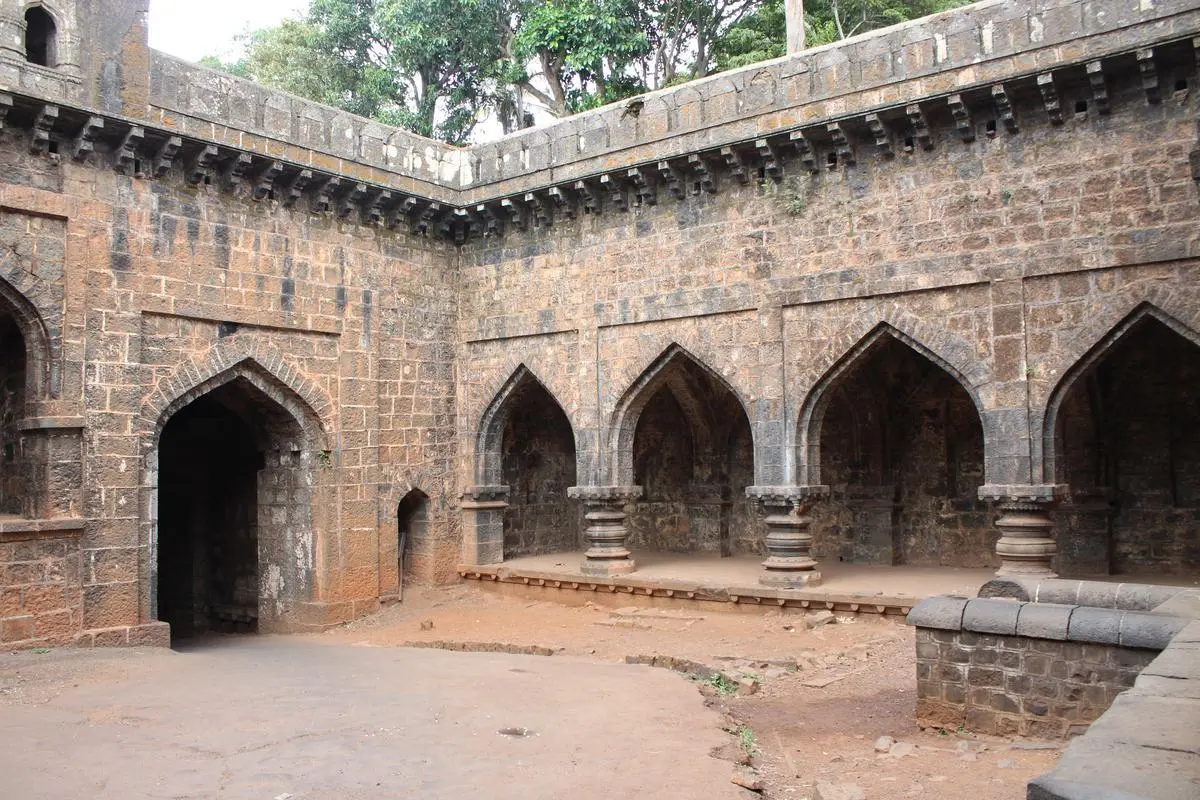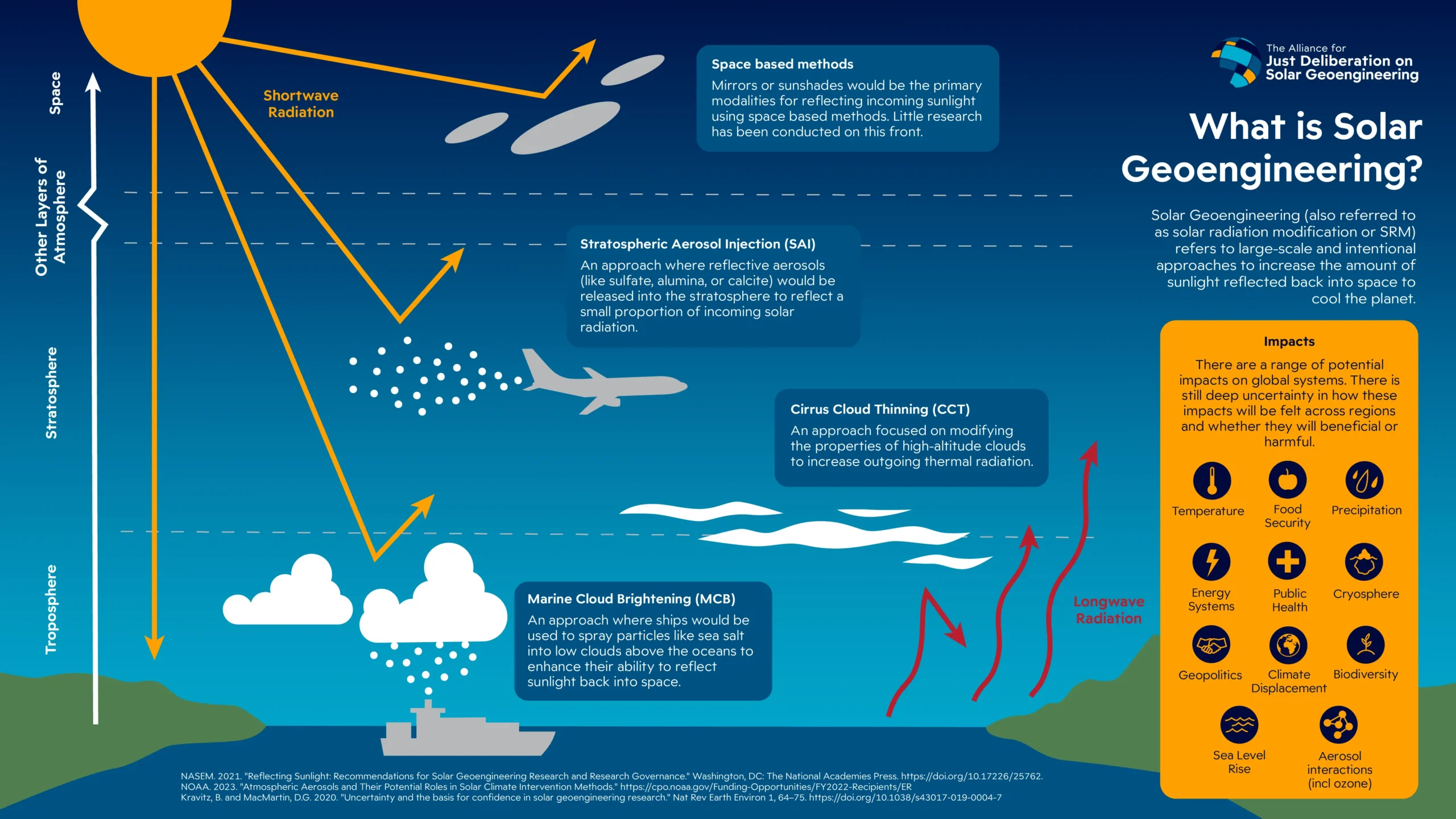GS Paper 1
Chipko Movement
- News: Chipko Movement marks 50th Anniversary.
- Origins of Chipko Movement:
-
- The Chipko movement originated in 1973 in the Reni Forest of Chamoli district, Uttarakhand (formerly Uttar Pradesh).
- Led by Sundarlal Bahuguna, Gaura Devi, and others, it was a non-violent protest against the felling of trees in the Himalayas.
- Gandhian social activist Chandi Prasad Bhatt, founder of the cooperative organisation Dasholi Gram Swarajya Sangh, led the first Chipko movement near the village of Mandal in 1973.

- Meaning Behind “Chipko”:
-
-
- The term “Chipko” derives from the word “embrace,” reflecting the villagers’ action of hugging trees to shield them from being cut down by state contractors and private corporations.
-
- Historical Context:
-
-
- The Chipko movement traces its roots back to the 18th century when Rajasthan’s Bishnoi community initiated a similar movement to protect sacred trees.
-
- Conflict Over Resources:
-
-
- The movement highlighted the tension between the livelihood needs of impoverished villagers and the government’s push to generate revenue through timber sales.
-
- Role of Women and Ecofeminism:
-
- The Chipko movement gained renown for its mobilization of women, emphasizing the principles of ecofeminism.
- Ecofeminism underscores the historical connection between women and nature across cultures, arguing that both have been oppressed and exploited by patriarchal societies.
Panhala Fort
- News: Archaeological Survey of India (ASI), Mumbai Circle celebrated World Heritage Day (April 18th) at Panhala Fort.
- Location: Maharashtra.
- History of Panhala Fort:
-
- Originating in the 12th century, the fort was constructed by the Shilahara dynasty of Kolhapur.
- Locally, the Panhala Fort was known as the abode of serpents and traditionally associated with the sage Parashar.

- Political Significance:
-
-
- Queen Tarabai was the founder of the Panhala throne of Karvir alias Kolhapur princely state.
- Shilahara dynasty, Yadava and Bahamani kingdoms, Shivaji, Devagiri Yadavas, Adil Shahi dynasty of Bijapur army, Mughal Aurangzeb (1700) became the controllers of the fort from time to time.
-
- Architectural Features:
-
-
- Entrances: Chaar Darwaja,Teen Darwaja, Wagh Darwaja
- Water bodies: Someshwar Tank, Sadhoba Tank, Khokad Tank , Idgah Tank, Andhar Vav
- Nayikinicha Sajja: dancing girl’s tower
- Ambarkhana: consists of 3 buildings known as the Ganga, Yamuna and Saraswati.
- Sajja Kothi: highest position on the hill
-
- Strategic Importance:
-
-
- Panhala served as the Maratha state capital under Tarabai until 1782, before falling under British rule in 1827.
-
- Geographical Significance:
- It is strategically placed in proximity to the trade routes connecting the Sahyadri mountains, the Deccan plateau, and the Konkan coast.
Read also: UPSC Civil Services Exam: Who’s Right for the Challenge?
GS Paper 2
Unique ID For Organ Donation
- News: The Union Health Ministry has issued the directive to eliminate commercial dealing in organs especially those involving foreign citizens.
- Implementation of NOTTO-ID:
-
- All cases of organ transplants, whether from living or deceased donors, will receive a unique National Organ and Tissue Transplant Organisation (NOTTO)-ID for both donors and recipients.
- NOTTO-ID is mandatory for organ allocation in deceased donor transplants, while in living donor transplants, it must be generated within 48 hours post-surgery.
-
- Quality Assurance Measures:
-
- There shall be regular inspections of registered hospitals for transplant/retrieval by appropriate State authorities.
- On-site monitoring will ensure adherence to transplantation quality standards, post-operative follow-up of donors and recipients, and assessment of outcomes.
-
- Enforcement and Accountability:
- Violations of the Transplantation of Human Organs Act (THOTA), 1994, and its rules will be thoroughly investigated.
- Appropriate actions, including suspension of registration for performing organ transplants, will be taken against hospitals engaged in illegal activities.
- National Organ and Tissue Transplant Organization (NOTTO):
- Definition: It is a National level organization set up under Directorate General of Health Services, Ministry of Health and Family Welfare, Government of India.
- Aim: National Network division of NOTTO functions as apex centre for:
- All India activities of coordination and networking for procurement and distribution of Organs and Tissues and
- Registry of Organs and Tissues Donation and Transplantation in the country.
- Divisions: NOTTO has two divisions:
- National Human Organ and Tissue Removal and Storage Network: This has been mandated as per the Transplantation of Human Organs (Amendment) Act 2011.
- It is the nodal networking agency for Delhi and shall network for Procurement Allocation and Distribution of Organs and Tissues in Delhi.
- National Biomaterial Centre: The Transplantation of Human Organs (Amendment) Act 2011 has included the component of tissue donation and registration of tissue Banks.
- The main aim of establishing this centre is to fill up the gap between ‘Demand’ and ‘Supply’ as well as ‘Quality Assurance’ in the availability of various tissues.
Salas y Gómez
- News: During exploration of the Salas y Gómez region, scientists have uncovered 160 new marine species.
- Introduction: The Salas y Gómez region is characterized by an underwater mountain chain.
- Location: Situated in the Southeastern Pacific Ocean, the region extends from west to east.
-
- Its western side intersects with the East Pacific Rise within Chilean waters, near Easter Island, while its eastern side connects to the western end of the Nazca Ridge.
-
- Ecosystems: Ecosystems within this area are uniquely isolated by the Atacama Trench, the Humboldt Current System, and an extreme oxygen minimum zone.
- Significance of the Region:
- Unique Biodiversity: Hosts remarkable biodiversity with some of the highest levels of marine endemism found on Earth.
- Consideration for Marine Protection: Under consideration for designation as a high seas marine protected area, particularly once the UN High Seas Treaty is approved.
- United Nations High Seas Treaty:
- Introduction: The UN High Seas Treaty often referred to as the Paris Agreement for the Ocean, focuses on Biodiversity Beyond National Jurisdiction.
- Mandate: The treaty pertains to the ocean beyond Exclusive Economic Zones (EEZs), which extend approximately 200 nautical miles from a country’s coastline.
- Countries hold special rights for exploration within their EEZs.
- India’s Position: India has not signed the treaty.
- Exclusive Economic Zone (EEZ): It is a designated area of the ocean extending up to 200 nautical miles (approximately 370 km) from a country’s coastline.
- Within this zone, the country retains exclusive rights to explore and exploit natural resources.
National Consumer Disputes Redressal Commission
- News: Supreme Court has sought explanation from 2 NCDRC members for issuing non-bailable warrants ignoring SC’s interim protection.
- Establishment and Jurisdiction:
-
- The National Consumer Disputes Redressal Commission (NCDRC) was established in 1988 under the Consumer Protection Act of 1986.
- It serves as a quasi-judicial commission with jurisdiction over consumer disputes valued at more than two crore rupees.
-
- Leadership:
-
- It is headed by a sitting or retired Judge of the Supreme Court of India or a Chief Justice of a High Court.
- Presently, the commission is led by Honorable Mr. Justice Amreshwar Pratap Sahi, former Chief Justice of Patna and Madras High Courts.
-
- Mandate and Powers:
-
- Jurisdiction: As per Section 21 of the Consumer Protection Act, 1986, the NCDRC has jurisdiction to entertain complaints valued at more than two crore rupees.
- It also exercises Appellate and Revisional jurisdiction over orders of State Commissions or District Fora.
- Jurisdiction: As per Section 21 of the Consumer Protection Act, 1986, the NCDRC has jurisdiction to entertain complaints valued at more than two crore rupees.
-
- Appeal Procedure: Section 23 of the Consumer Protection Act, 1986, allows any aggrieved person to appeal against an order of the NCDRC to the Supreme Court of India within 30 days.
- Headquarters : The NCDRC is headquartered in New Delhi.
- Quasi-judicial Body:
- A quasi-judicial body has powers vested in the commission established by law, administrative officers, or bodies to determine the rights of those who appear before it.
- Limited Scope of Authority: These bodies typically possess jurisdiction restricted to specific areas of expertise and authority, such as land use and zoning, financial markets, and public standards.
- Examples of Quasi-Judicial Bodies: National Human Rights Commission, National Commission for Women, and National Commission for Minorities etc.
Global Alliance for Incinerator Alternatives (GAIA) Asia Pacific
- News: The Global Alliance for Incinerator Alternatives (GAIA) Asia Pacific has called on the Association of Southeast Asian Nations (ASEAN) to take decisive action in response to plastic pollution.
- Global Alliance for Incinerator Alternatives (GAIA) Asia Pacific
-
- It is a worldwide alliance of more than 800 grassroots groups, non-governmental organisations and individuals in over 90 countries.
- It aims to power a transition away from our current linear and extractive economy and towards a circular system that supports people’s right to a safe and healthy environment.
- Primary points of intervention: incineration, zero waste, plastic, and climate.
- What is Incineration?
- It is the process of burning hazardous materials at temperatures high enough to destroy contaminants.
- Incineration is conducted in an “incinerator,” which is a type of furnace designed for burning hazardous materials in a combustion chamber.
- Many different types of hazardous materials can be treated by incineration, including soil, sludge, liquids, and gases.
- Despite its effectiveness, incineration raises environmental concerns, particularly with older facilities lacking proper gas cleaning or combustion controls.
Ashwagandha (Withania somnifera)
- News: Ashwagandha is now gaining worldwide attention.
- Introduction to Ashwagandha: Ashwagandha, also known as Indian ginseng or Indian winter cherry, is an evergreen shrub found in parts of India, Africa, and the Middle East.
- Etymology: The name “Ashwagandha” is derived from the Sanskrit words ‘ashwa’ meaning horse and ‘gandha’ meaning smell, referring to the horse-like odor of its roots.
- Taxonomic Classification: Belonging to the Solanaceae, or nightshade, family, Ashwagandha shares the same botanical family as tomatoes and potatoes.
- Health Benefits:
- Medicinal Usage: It has been utilized as a medicinal herb in Ayurvedic medicine for centuries.
- Adaptogenic Properties: Classified as an adaptogen, Ashwagandha aids in stress management and restoration of physiological balance.
- Health Effects: Its benefits encompass reducing inflammation, boosting energy levels, alleviating anxiety and pain, and improving sleep quality.
- Bioactive Compounds: Different parts of the plant, including the roots, leaves, and berries, contain varying levels of bioactive compounds. e) Key Compounds:
- Among the most notable compounds are withanolides, natural steroids renowned for their antioxidant and anti-inflammatory characteristics.
Claiming Copyright Over Textbooks
- News: Recently, the Andhra Pradesh High Court made a ruling stating that textbooks containing mathematical equations and scientific content are not subject to copyright protection due to their non-literary nature.
- What is copyright and when is it infringed?
-
-
- Copyright refers to the right given by the law to creators of literary, dramatic, musical, and artistic works and producers of cinematograph films and sound recordings.
- It is a bundle of rights that includes rights of reproduction, communication to the public, adaptation, and translation of a work.
- The 1957 Act aims to safeguard creative works considered to be a creator’s intellectual property.
- A copyrighted work will be considered “infringed” only if a substantial part is made use of without authorisation.
- In cases of infringement, the copyright owner can take legal action and is entitled to remedies such as injunctions and damages.
-
- Ruling of High Court:
-
- In 2010, the Andhra Pradesh government issued an order aiming to combat piracy by restricting private schools and colleges from publishing state textbooks.
- However, the court ruled that textbooks are not subject to copyright laws.
- This decision was based on the understanding that such books are intended for the benefit of students, thus falling under the protection of Section 52 of the copyright act, which allows for fair use in educational contexts.
- Despite recent warnings from NCERT regarding copyright infringement of educational materials, courts have consistently sided with publishers, exempting their work from copyright law in previous judgments.
Crime GPT
- News: Crime GPT is using AI to help police forces with crime detection.
- Crime GPT is a new AI tool created by Gurugram-based tech startup Staqu Technologies.
- In 2018, this company created Trinetra 1.0, a platform that allows police forces to digitise their criminal records, including photographs and other key details.
- In its next phase Trinetra 2.0, the Crime GPT can also analyse the unstructured data in the form of text.
- Crime GPT can sift through the database, identify relevant records, and provide detailed information of the suspect’s history, associated crimes, and even list police stations with his recorded offences.
- Crime GPT revolutionizes information delivery for law enforcement, boosting efficiency and public safety with timely and accurate data.
Marine Cloud Brightening (MCB)
- News: Scientists are exploring an unconventional approach to combat global warming through Marine Cloud Brightening.
- Marine Cloud Brightening: Marine Cloud Brightening (MCB) is a Solar Radiation Management (SRM) technique that aims to create whiter clouds in order to reflect more sunlight back to space and hence creating a cooling effect.
- How is Cloud Brightened?
- Formation of Warm Clouds:
- Warm clouds consist of small water droplets suspended in the air.
- The brightness of a cloud is determined by the number of small droplets it contains rather than the total water content.
- Nucleation Process:
- Each water droplet forms through the condensation of water vapor around a microscopic nucleus.
- Nuclei can be any minuscule particle present in the air.
- Role of Aerosols:
- Aerosols are tiny airborne particles found in the lower atmosphere.
- In clean maritime air, aerosols primarily consist of sulphates and sea salt crystals.
- Due to their limited presence, clouds formed in such conditions tend to have larger droplets.
- Enhancing Aerosols:
- To increase aerosols over marine areas, large volumes of tiny seawater droplets are sprayed into the atmosphere.
- As these droplets evaporate, they leave behind sea salt particles, augmenting the aerosol concentration in the air.
- Brightening Effect:
- The additional sea salt particles introduced into the clouds contribute to their brightness when incorporated into the cloud structure.

Ethylene Oxide
- News: Hong Kong Bans Sale of MDH and Everest Spices Due to Ethylene Oxide Contamination.
- Nature of Ethylene Oxide: Ethylene oxide is a colorless, flammable gas with a faint sweet odor.
- Applications:
-
- It is utilized in the production of various chemicals, including antifreeze, textiles, plastics, detergents, and adhesives.
- Additionally, ethylene oxide serves as a pesticide and sterilizing agent for medical equipment.
-
- Health Impacts:
-
- Prolonged exposure to ethylene oxide can lead to irritation of the eyes, skin, and respiratory passages, as well as affect the nervous system.
- Furthermore, ethylene oxide is classified as carcinogenic to humans, posing long-term health risks.
-
